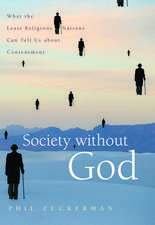The Mother Town: Civic Ritual, Symbol, and Experience in the Borders of Scotland
Autor Gwen Kennedy Nevilleen Limba Engleză Paperback – 21 iul 1994
| Toate formatele și edițiile | Preț | Express |
|---|---|---|
| Paperback (1) | 310.68 lei 31-37 zile | |
| Oxford University Press – 21 iul 1994 | 310.68 lei 31-37 zile | |
| Hardback (1) | 327.26 lei 31-37 zile | |
| Oxford University Press – 21 iul 1994 | 327.26 lei 31-37 zile |
Preț: 310.68 lei
Preț vechi: 340.03 lei
-9% Nou
Puncte Express: 466
Preț estimativ în valută:
59.46€ • 61.84$ • 49.08£
59.46€ • 61.84$ • 49.08£
Carte tipărită la comandă
Livrare economică 03-09 aprilie
Preluare comenzi: 021 569.72.76
Specificații
ISBN-13: 9780195090321
ISBN-10: 0195090322
Pagini: 176
Ilustrații: frontispiece, halftones, line drawings
Dimensiuni: 156 x 235 x 10 mm
Greutate: 0.31 kg
Editura: Oxford University Press
Colecția OUP USA
Locul publicării:New York, United States
ISBN-10: 0195090322
Pagini: 176
Ilustrații: frontispiece, halftones, line drawings
Dimensiuni: 156 x 235 x 10 mm
Greutate: 0.31 kg
Editura: Oxford University Press
Colecția OUP USA
Locul publicării:New York, United States
Recenzii
No one brings anthropology 'home' quite like Neville. The Mother Town is full of insight and provocative thoughts about the deeper structures of community and individual in the West.
Thoroughly enjoyable and stimulating reading that will prove to be an important contribution to the symbolism of cultural identity in civic ritual.
Grounded in meticulous fieldwork, Dr. Neville's compelling study of the Common Riding ceremony both deciphers and engages in what she calls 'skirmishes for meanings.' These skirmishes make visible the complex processes that construct the cultural scripts for individuals as they are incorporated in a town with its integral medieval-modern socioeconomic structures. Of equal interest to literary critics as to anthropologists, Dr. Neville's elegant presentation opens a wealth of theoretical vistas without ever losing sight of the concrete particularities of the central ritual and the historical continuities and discontinuities it embodies.
Dr. Neville writes clearly and vividly. Her descriptions are immediate and colorful and her interpretations incisive yet compassionate. She says important things about aging, going away and coming home, towns, classes, community, history, and Scotland as part of a European pattern.
Through the ritual detail of the Common Riding of the Border Towns of Scotland, Dr. Neville explores the emergence of the individual citizen from the corporate medieval world, and the mediating role of the Mother Town in this transition in Western European Protestant culture. Moving between various levels of discourse (an 'ethnological collage'), Dr. Neville alternates beautifully written 'thick description' with clear and penetrating social analysis. The book points out that the 'town' is a social product of a certain historical, cultural, and economic moment. What I especially like about this book is that it deals with a ritual form from English-speaking Europe. It, thus, serves a mediating role for the dominant American culture that assumes that only Others have a rich ritual life.
Thoroughly enjoyable and stimulating reading that will prove to be an important contribution to the symbolism of cultural identity in civic ritual.
Grounded in meticulous fieldwork, Dr. Neville's compelling study of the Common Riding ceremony both deciphers and engages in what she calls 'skirmishes for meanings.' These skirmishes make visible the complex processes that construct the cultural scripts for individuals as they are incorporated in a town with its integral medieval-modern socioeconomic structures. Of equal interest to literary critics as to anthropologists, Dr. Neville's elegant presentation opens a wealth of theoretical vistas without ever losing sight of the concrete particularities of the central ritual and the historical continuities and discontinuities it embodies.
Dr. Neville writes clearly and vividly. Her descriptions are immediate and colorful and her interpretations incisive yet compassionate. She says important things about aging, going away and coming home, towns, classes, community, history, and Scotland as part of a European pattern.
Through the ritual detail of the Common Riding of the Border Towns of Scotland, Dr. Neville explores the emergence of the individual citizen from the corporate medieval world, and the mediating role of the Mother Town in this transition in Western European Protestant culture. Moving between various levels of discourse (an 'ethnological collage'), Dr. Neville alternates beautifully written 'thick description' with clear and penetrating social analysis. The book points out that the 'town' is a social product of a certain historical, cultural, and economic moment. What I especially like about this book is that it deals with a ritual form from English-speaking Europe. It, thus, serves a mediating role for the dominant American culture that assumes that only Others have a rich ritual life.














